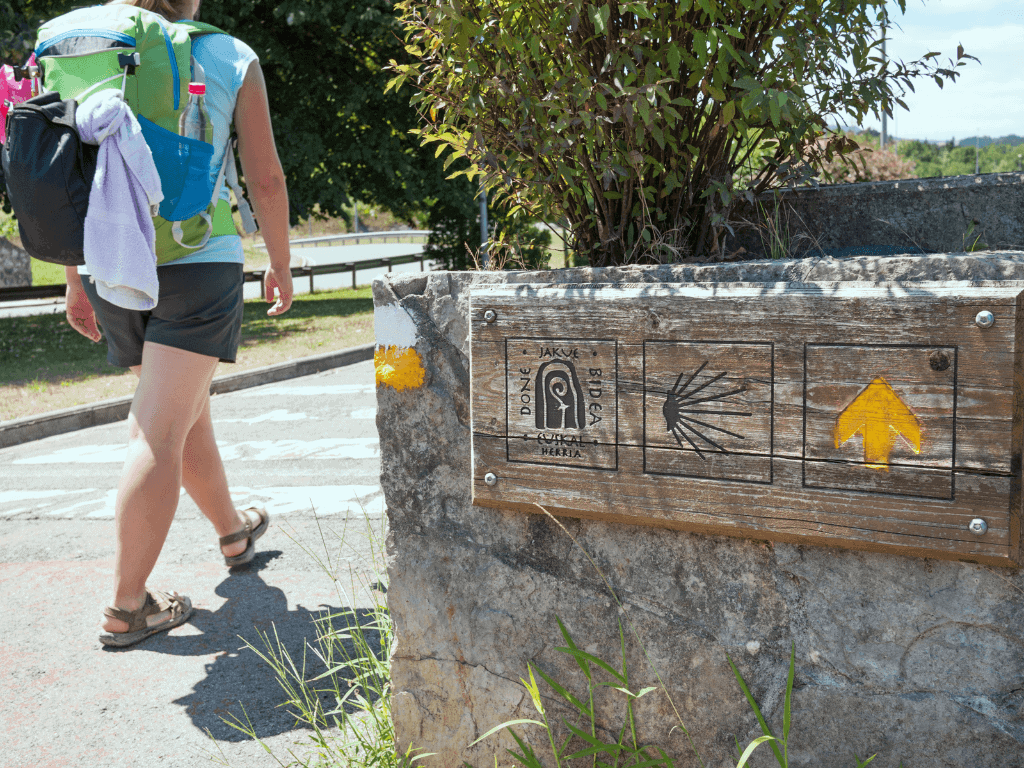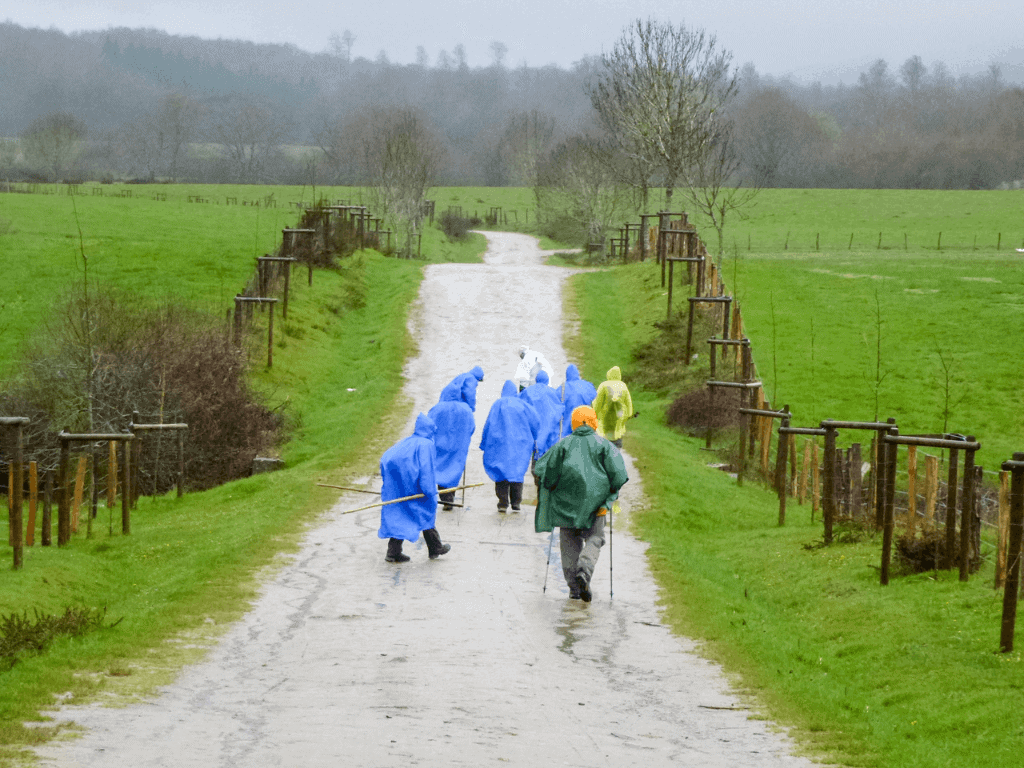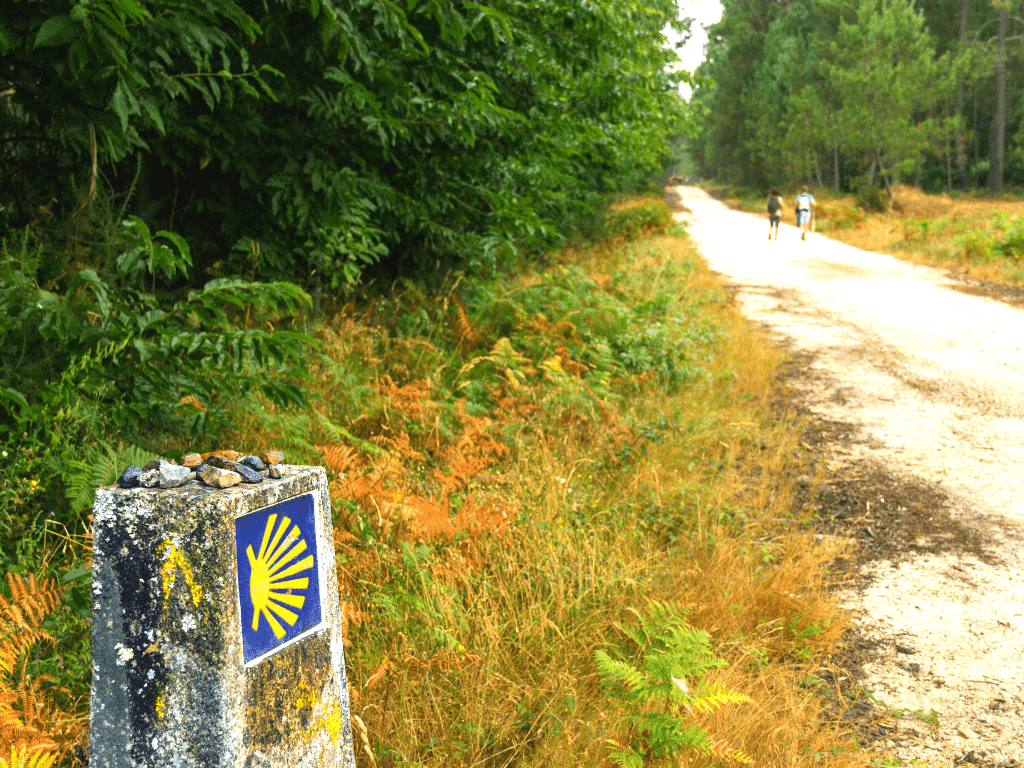Is the Camino de Santiago safe? Top 10 Safety Tips
Disclaimer: This article may contain affiliate links. For full information, please see our disclaimer here.
Thinking about walking the Camino de Santiago? This article answers the question, “Is the Camino de Santiago safe?” and includes practical Camino safety tips.
Walking the Way of St. James is truly the trip of a lifetime. Unplugging, getting into nature, and fellowshipping with other pilgrims are all simple pleasures that are waiting for you on the trail.
However, as you’re getting more excited at the prospect of undertaking the introspective journey or are packing to leave, a little voice inside you may be questioning your safety.
Or, very likely, your family is convinced the Camino de Santiago is dangerous—even though they haven’t done their research. So, you need some info to appease their worries.
In this post, you’ll see by and large walking the Camino in Spain is a safe activity.
So, let’s get started with some Camino safety info to help you plan your Camino!
Is walking the Camino de Santiago safe?
A misconception about the Camino is that you’ll be out in the middle of nowhere with no safety net. In fact, it’s just the opposite. The Camino is a well-traveled tourist trail these days, welcoming over 350,000 pilgrims 2019 (Source: Pilgrim’s Office).
With the increase in popularity comes more infrastructure to support pilgrims’ safe—any enjoyable—passage along the Way. From excellent signage to ensure you are on the correct path to an entire system dedicated to luggage transport, you’ll quickly see you’re in good hands.
Of course, it’s not to say that heinous things never happen. From time to time, there have been reports of violent incidents. However, Spain is reported as the one of the safest countries in the world. Even better, the Spanish authorities (the policia nacional and the guardia civil) operate along Camino.
They even redoubled their efforts for the 2021-2022 holy year with a program we hope to see continue.
Although there are rare incidents, Spanish authorities and Camino-related tourism boards maintain the trail is safe and welcome visitors to come experience “the spirit of the Camino.” (The “spirit of the Camino refers to the widespread camaraderie on the Camino, especially along its popular Camino Frances route.
Plus, if you were to become a victim, it’s more likely that you’ll encounter petty theft than violent crime. We’ll detail how you can best protect yourself, below.
Now that you see the stats are on your side, let’s get into some practical ways you can stay safe along the Camino.
Tips for Camino Safety
Although the Camino de Santiago is generally safe, there are some precautions you can take to protect yourself and your trip. Here are 10 tips for staying safe along the Saint James Way.
1. Get a data plan for emergencies
As much as you’d like to disconnect from technology on your pilgrimage, it’s wise to carry a cell phone for emergencies. The emergency number in Spain is 112; program it in your phone before departure.
In addition to phone service, you’ll need browsing data so that you can access the AlertCops app. AlertCops allows you to contact the police immediately on your phone in addition to automatically sending your position to the police, no matter what language you speak. Don’t forget to register your account before you leave.
To use your phone abroad, you have a few options:
Purchase an esim on Aiaralo prior to departure. This is an affordable option with great coverage in Spain. Plus, you’ll have peace of mind knowing you have cell coverage when you land! Buy an esim for Spain here.
You can also add international data to your current phone plan, but that can get quite expensive! (I love T-Mobile since data is included abroad!)
Lastly, you can buy data through a local provider like Orange or Movistar when you land.
2. Avoid petty theft

Sadly, one of biggest risks along the Camino is actually the same as a risk to travelers everywhere: petty theft.
Petty theft means having valuable items stolen or pickpocketed from you in a place where a thief is legally allowed to enter like at a restaurant, on public transport, or in a hostel. Most commonly, thieves steal cash, passports, and other small items of value that are easy to snatch.
Here are some tips to avoid being the victim of petty crime:
Keep valuables on you at all times
Plan to keep your valuables with you at all times: walking, shopping, cooking, doing laundry, showering, sleeping, etc.
Most pilgrims bring some sort of small security pouch. Here are some favorites, but you can choose whatever is most comfortable to you:
- Fanny pack – Perfect for easy access to all valuables while wearing my backpack.
- Crossbody – Many like the security of holding onto a crossbody bag, but I don’t like having extra weight on one shoulder all day.
- Convertible waist bag/crossbody – I prefer a fanny pack that I can also use as a crossbody. I wear it as a fanny pack during the day and as a crossbody when I’m out in the evenings.
Don’t leave valuables in plain sight
To avoid being a victim of theft at an albergue, never leave money, passports, cell phones, etc. lying in plain sight. Even tucking them under your pillow isn’t a good idea—that’s the first place a petty thief will look!
Bring a small travel lock if you’d like to lock your pack, but please note that hiking backpacks aren’t typically designed with security in mind.
Don’t carry large amounts of cash
Just in case you do get robbed, or if you lose your bag, we don’t want you to lose all your cash! Take out what you need in small increments. There are ATMs all along the Camino, and some hostels and hotels accept credit cards, too.
💡 Editor’s Note: All information on Camino safety should be considered educational in nature. It’s up to you to make decisions for yourself as to where, when, and if you decide to walk the Way.
3. Stay hydrated, and take rest breaks

When people ask if the Camino is safe, they are usually referring to violent crime, theft, or getting lost. But heat exhaustion, heatstroke, and even hypothermia are real safety concerns, too.
Every year, there are reports of pilgrims having to leave the trail due to these conditions.
To protect yourself, get a big water bottle and fill up often, pay attention to the weather, and take frequent rest breaks.
Learn the symptoms of heat exhaustion and heatstroke and hypothermia.
4. Pack appropriate clothing and gear

Walking the Camino de Santiago is no picnic. Whether you’re undertaking a month-long trail or walking the last 5-6 days from Sarria, you need to wear and carry appropriate gear.
This includes:
- Backpack – When worn correctly, backpacks will actually distribute most of their weight to your hips and legs and can become quite comfortable. Invest in a backpack, and you’ll be able to use it for years to come. See our backpack guide to get started.
- Quick dry clothing – Get clothes that keep you dry and wick moisture from the body in all temperatures. Merino wool and other clothing labeled dri-fit or quick-dry should be considered when choosing gear.
🎒 See our Camino de Santiago packing list for the best advice on what to bring on your Camino. You can even download a copy!
5. Walk during the day

Although you might not be an early riser at home, you’ll be surprised how alluring the thought of walking with the sunrise becomes.
Yes, one of the great pleasures of the Camino is heading out before dawn to avoid the heat, crowds, and of course, enjoy the beauty of the sunrise.
If you’re alone, however, you may want to think twice about leaving when dark. Instead, wait until first light to get on the trail, or find someone to walk with.
The same thing goes for evening—always get to your next destination before dark. If it’s getting late, you can always call a taxi cab to pick you up.
6. Ask locals for help
The villages you’ll pass through are intimately tied to the Camino. To explain, businesses that cater to pilgrims like cafes, laundromats, and luggage transport wouldn’t exist without pilgrims passing through!
As for the locals—business owners or not—you get the feeling they are all watching out for you. By and large, they’ll wish you well on your journey with a friendly, “Buen camino!” They’re also apt to point out when you’re going the wrong way and give you trail advice.
If you’re ever wondering how long it takes to get to the next water stop, for example, ask a local. If you don’t speak Spanish, get the Google translate app on your phone. Although it’s far from perfect, it can do wonders to help you communicate in a pinch.
7. Travel in a Camino family, or at least, make some friends

The general consensus is that it’s safe for pilgrims to walk the Camino alone. In fact, I learned so much on my first Camino that recommend anyone who is able to set off on their own solo pilgrimage!
That being said, you might feel nervous, lonely, or worried about your gear being stolen from time to time. Luckily, it’s very easy to make friends along the Camino. Sometimes you get along so well, you become what’s called a “Camino family.” Some people walk with their Camino families for just a few days, others end up walking all the way to Santiago together!
Whatever the case, it’s always nice to have someone watch your back. Don’t be afraid to strike up a conversation and partner with a buddy when needed.
8. Get a guidebook or App

One of the big fears along the Camino is getting lost. Well, in this respect, the Camino is very safe. The trail is well marked with yellow arrows!
Even so, getting a guidebook is an absolute must. Not only will you be able to check the maps, you’ll access pertinent information like elevation gains (important to take into consideration for avoiding injury), where grocery stores are located, and much much more.
There are also several useful apps like Buen Camino and Wise Pilgrim where you can track your progress. If you ever wonder if you’ve strayed from the path, simply open the app and see where you are using the GPS!
9. Adhere to road safety

There are parts of the Camino that run on gorgeous countryside paths. Other times, you find yourself walking on the side of a road or highway.
Take precautions so that you do not get struck by a vehicle (which has tragically occurred a few times in recent years):
- Stay on the shoulder, sidewalk, or as close to the left side of the road as possible.
- Walk against oncoming traffic.
- Walk in a line with other pilgrims; do not spill out into the roadway.
- Take extra care when crossing the road, looking left, right, and left again.
- Try to avoid walking in dimly lit conditions; wear light and reflective material if you do.
- Obey traffic signals and establish eye contact with drivers before crossing at a crosswalk.
10. Get travel insurance

One of the most important tips for Camino safety is to get travel insurance for the Camino because no matter how much planning you do, accidents happen.
Insurance will offer you the peace of mind that if you do get an injury, miss a flight, lose your luggage (or have it stolen from you!) you’ll be well taken care of. Don’t go on the Camino without it!
In general, we recommend these three companies for travel insurance:
- Travel Insurance Master: This insurance aggregator shows you the best plans available from the top travel insurance providers. Compare rates here.
- Safetywing: This is digital nomad insurance with the cheapest rates online. You can subscribe for an entire month for a fraction of what other insurance costs!
- World Nomads: Adventure travel insurance (under age 70)

Frequently Asked Questions About Camino Safety
1. Is there crime along the Camino de Santiago?
From time to time, there have been reports of violent crime along the Camino. But, these are few and far between. The biggest risk is more likely petty theft. Pilgrims have reported their belongings in hostels in the larger cities and along the Camino del Norte being stolen from time to time. Women also report seeing men behaving indecently on the trail. The best thing to do is to be aware of your surroundings, have the AlertCops App downloaded on your phone, and to walk during daylight hours.
2. Is it safe to walk the Camino de Santiago alone?
Any pilgrim will tell you, “you never really walk alone.” It’s very true. As long as you stick to the major routes (and especially in high season), you’ll have hikers both in front of you and behind you all day long. So, yes, in general its safe to walk the Camino de Santiago alone. Just take precautions like you would anywhere else.
3. How do I get a data plan for the Camino?
Cell coverage along the Camino Frances, at least, is very good. You may get an international plan on your phone, or buy a sim card with data upon arrival in Spain. (We have T-Mobile which includes international data and had coverage 99% of the time along the Camino Frances. I highly recommend T-Mobile if you travel a lot!) Even if you want to unplug on your journey, I recommend you do get coverage
4. Is the water safe to drink in Spain?
Yes, the water is safe to drink in Spain straight from the tap. There are plenty of fountains along the Camino, most of which are drinkable. They often have a sign indicating if they are not potable. Feel free to fill up your water bottle as you go. You can also fill up at the tap in any albergue, or ask a bar owner to fill your bottle for you.
5. Is it easy to get lost on the Camino de Santiago?
The Camino is well marked with yellow arrows and scallop shells. You will see them everywhere- on the ground, on poles, spray painted on the ground, etc. Generally, you will see them every mile or two. That doesn’t mean that you may not miss one from time to time. If it’s been an inordinate amount of time, you may want to stop and check on an APP where you are, just to be sure.
6. Are there bathrooms on the Camino de Santiago?
Yes, there are plenty of bathrooms along the Camino, especially along the Camino Frances. Every few miles, there will be an open café with restrooms. It’s customary to buy a coffee or a bottle of water in exchange for using the facilities, which are modern and clean.
7. Should I get travel insurance for the Camino de Santiago?
Absolutely! Whether you are going on a city break or a mountain trek, we do recommend you purchase travel insurance. From flight delays to lost luggage, travel insurance can help! What’s more, walking the Camino, you do risk physical injury. Should you get sick or hurt yourself, you’ll be glad that you got insurance! Get a quote with World Nomads.
Camino de Santiago Travel Guide
🏨 Where should I book accommodations for the Camino?
Search Booking.com hotels, hostels, B&Bs, and guesthouses on the Camino.
🚉 How do I buy train or bus tickets in Spain?
Search for train tickets in Spain on Omio which will show you the best selection of trains and buses. Trainline and Busbud are also great to cross-reference, as no one platform has every route!
📱 Where can I get cellular data for Santiago de Compostela?
Try using Airalo, the world’s first eSIM store! Download, and install your eSIM, and get connected as soon as you land.
📃 Should I buy travel insurance for the Camino de Santiago?
Yes! Protect your investment from trip interruptions to unexpected injuries — compare rates on Travel Insurance Master and SafetyWing (which has some of the cheapest rates when you subscribe to a 1+ Month plan).
🎒 How can I book backpack transport on the Camino?
To arrange for backpack transfer on the Camino, check with Jacotrans or Pilbeo.
✈ What are the best sites to book flights within Spain?
Search Skyscanner for best flights that other search engines miss!
🏙 Where do I find the best Santiago de Compostela tours?
Search for top-rated Santiago de Compostela tours or day trips (with reviews!) on Viator and/or Get Your Guide.
🥾 What should I pack for the Camino de Santiago?
Download the Camino de Santiago packing list.
Go to our resources page for more booking tools we use to plan our trips.
Conclusion
Many first-timers find hiking the Camino exhilarating.
But, if you’re wondering, “Is it safe to stay to walk the Camino,” you’re not alone. It’s normal to feel some unease around such a big undertaking.
We hope this list of Camino safety tips has helped ease your worries because in general, yes, walking the Camino is safe.
It’s time to start training and put the ideas we’ve listed here into practice, and start living your Camino dreams! Because if you don’t—you’re missing out on the trip of a lifetime!
Pin it!

